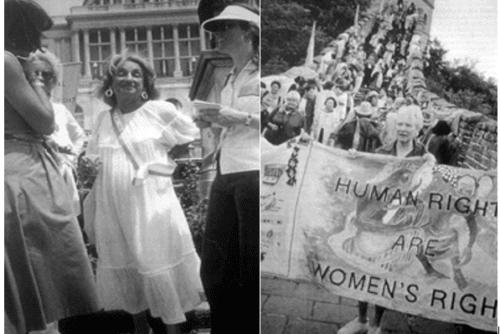[Note: This essay is excerpted from a longer article, which will appear in TDR in 2004.]
I almost married this Irish-American guy. . .
I even went down to meet his family, and they lived in Sarasota, Florida. . . .
Like I love his family but they were kinda too nice to me. So the whole time I felt really like “Oh, this is my host family [starts bowing]. I come from Asia [bows from the waist three times, slowly.] America is numbah one [bows again]. Sank you mistah Eddy’s faddah.” [bows and stays low]
If one had to pantomime Oriental deference on the Western stage, one would be hard pressed to find a gesture better suited to this work than the bow. A pose so iconically Asian, the bow appears only to enhance the yellowface persona that the comedienne, Margaret Cho, throws on with her other accessories – the affected accent, the mincing steps, and the reference to a “host family” – all to suggest that the domestic civility of her prospective in-laws – their being overly “nice” – casts her own relationship to them in a global light, one of international exchange following a particular model, that of white-ethnic families’ sponsoring Asian foreign students.
As Cho deploys it, the bow – a civil gesture – hides an aggression, or more accurately, it makes apparent an aggression, an uneven relation of racialized power between whites and yellows, between races defined by distinct interpellation in relations of production (labor) and exchange (capitalist consumption). Prior to her actual visit to Sarasota, Cho anticipates another kind of social interaction more transparently revelatory of the racial disjunctures and spatial segregation operating historically between people of color and whites in the United States: “I asked [my boyfriend], ‘Are there gonna be any Asian people there [in Sarasota]?’ And he was like, ‘No.’ And I said, ‘Okay. . . . Could you just drop me off at the dry cleaner then? [beat] Cause I don’t want to be the only one.'” Through such historical references, Cho pokes fun at those who would view the bow as merely an Oriental flourish. To see Cho’s mimicry of Asian obedience as the mere staging of quaint international differences – bowing versus hand-shaking – rather than historical racial relations is to adopt a view that the artist would surely call “too nice,” made possible only through the repression of historical memory, and a deliberate ignorance of prior performative references.
As Cho bends and holds her upper half parallel to the floor, one cannot but help see in this body position a citation to an earlier bit on the Chippendale dancers:
The Chippendale dancers are gay. [beat] They’re gay. You know why? Because there is no such thing as a straight man with a visible abdominal muscle. Doesn’t exist. You need to suck cock [Cho bends slowly over] to get that kind of muscle definition.
Cho speaks these last lines to the floor. Her body is engaged in a prostration, in a (homo)erotics, in a social ritual of bowing, and in a geopolitically inflected movement, all at once. The repositioning of the body, or parts of the body repositioning themselves, occurs in both a visual register (the spectacle of the bow) and in a verbal register (the reference to traveling to Sarasota signifies a repositioning of the body, as does the reference to raised abdominals). I will be taking this repositioning of the body as a starting point to inquire into how the Asian American performer, Margaret Cho, intervenes in public space through the stand-up comedy concert and how her theatrical and literary seizing of public space interarticulates with the condition of already possessing a publicized body. Through the sensate body and its leakiness – its inadequate partitioning according to geopolitical, gendered, or domestic(ating) principles of space – Cho both stages her own ambiguous body and comments on the political compulsion to disavow the erotics and slippage of the body in order to speak publicly, rationally, and abstractly. In essence, Cho returns this fully sensate body to the audience, rendering political knowledge through affect, critiquing the boundaries that set apart historical knowledge from bodily pleasure, and mocking not just the alienation of racially and sexually marked bodies from the proper (civilized) representational field, but also of the mechanism of this alienation itself.
In my examination of Cho’s comedy act and her memoir, both entitled I’m the One that I Want, I take up the literal site of performance (the bare stage) as a space of assemblages, as a platform for revealing the body’s leakage – its infirm boundaries and borders as well as its embeddedness in histories of migration. I use migration, here, to refer both to expulsions across national borders (for instance, Cho’s father is deported from America just three days after his wife gives birth) as well as to the more mundane vagrancy of stand-up performers who, with the rise of comedy chains in the 1980s, travel the national circuit as “road warriors” (Borns, Stebbins). Relief from the life on the road prompts Cho to develop a situation comedy for television broadcast, a comedy not only sporting the ubiquitous living room interior (carry-over from naturalist theater) but also incapable, ultimately, of simulating a homespace for “alien” Asians within the white world of television. My argument, however, is not that Cho is unable to find a home through Hollywood development but that home, itself, has become unsettled, revealed as a spatial arrangement whose ideality rests on imprisonment.



